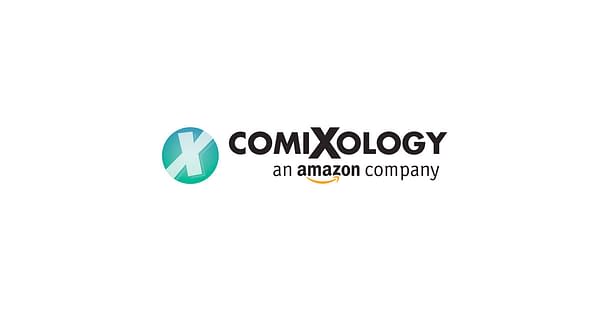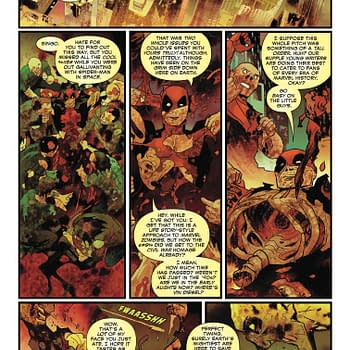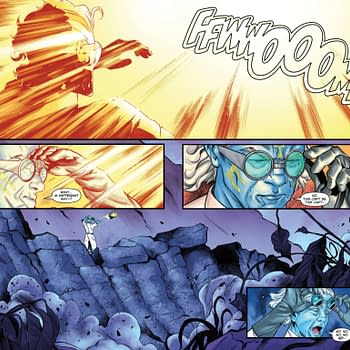Posted in: Comics, Comixology, Digital | Tagged: comixology, diamond, digital comics
As We Head Into the Next Decade, Is It Time to Rethink Digital Comics?
Ah, the new year. A time for change. For examining the past and looking forward to the future. For cranking out think-pieces on a holiday to fill an article quota. The perfect time to talk about comics' greatest failure: digital comics.
When digital comics were first introduced to the superhero comics industry over a decade ago, they were meant to be the future of comics. But has it worked out that way? As of 2019, seemingly not. Physical comic book sales still vastly outstrip digital sales, and digital comics have failed to live up to the potential of exponential growth that we see with digital reading outside of the superhero industry, where webcomics have far more readers than even the highest selling Marvel or DC books. As we head into 2020, it's time to rethink the strategy on digital and how it can help comics readership grow.
To figure out what comics should be doing with digital, we need to look at why they haven't succeeded so far. The most important reason is the price. Physical comics have gone up in cost over the years for various reasons, but the most important one has been the dwindling of total comic book readers and the need to sustain the direct market system. Without a means of mainstream distribution of comics, there's no effective way to drive readers to comic book stores. Digital comics could be that means of mainstream distribution… but fear of upsetting the Diamond monopoly has artificially hamstrung them. A basic concept of business is that if you lower prices, you can sell more product, and though profit margins will be lower, overall profits will be up. Digital distribution is incredibly cheap compared to physical distribution. Once you make a digital version of a comic, you can sell infinite copies of it for only the cost of the bandwidth required to download it. But because comic book retailers are perpetually terrified of being put out of business, publishers can't lower the price of digital comics for fear that they'll cannibalize the physical market that sustains the current industry.
This culture of fear will forever prevent digital comics from reaching their true potential. But if publishers had the guts, they could reduce the price of digital comics to ninety-nine cents an issue and turn it from a luxury purchase that a potential buyer has to carefully consider to an impulse buy that potential readers will click on a whim. When a reader considers buying a digital comic today, they are thinking about spending four bucks on what is ultimately only one-fifth or one-sixth of a complete story, meaning they need to commit to a purchase of twenty dollars or more over the course of several months just to see if they like something. That's a barrier of entry that's too high. Comics have plenty of mainstream recognition thanks to all the successful superhero movies, television shows, video games, and merchandise, so why aren't millions of people buying the latest issue of Batman or Avengers on ComiXology? The most likely reason is that it just doesn't seem like a good value.
Sure, you say, making digital comics cheaper might get more people to read them, but it doesn't solve the issue of cannibalization of the direct market. Well, what if that fear is completely unfounded, and, in fact, the refusal to lower digital prices is actually hurting the direct market? The fact is that new comic book readers aren't coming to specialty shops in big numbers, and for the most part, superhero comics aren't tearing up the bookstore market either, where comics geared toward young readers by the likes of Raina Telgemeier and Dav Pilvey rule the roost and make Marvel and DC look like chumps. The reason is that there's no entry point for new readers, and that's exactly what digital comics could provide if they weren't prohibitively expensive to anyone who hasn't already been indoctrinated with superhero comics industry propaganda into believing that four bucks for one chapter of a story is somehow a fair and reasonable price. But don't take it from us. Just listen to Mile High Comics founder Chuck Rozanski, who wrote about the failed newsstand market years ago:
For those of you who are long-time readers of this column, you probably are already aware that I believe that the main reason why comics shops were able to rapidly supersede newsstands during the 1980's is because Direct Market comics distributors delivered comics to specialty stores approximately one week earlier than local newsstand distributors (ID's) supplied their accounts. Given that most hardcore comics fans are quite impatient to read the next issue of their favorite titles, this one-week shipping advantage quickly caused most avid comics fans to shift their business into the rapidly growing comics specialty stores network around the world.
While that sounds like a great development for the Direct Market, it actually ended up destroying the entry point of most new readers. While most comics specialty shops do a great job of servicing their existing clients, the distressing truth is that many shops inadvertently (or sometimes blatantly…) give the appearance of being private clubs, where only the already initiated need apply. Newsstands, on the other hand, are quite egalitarian, offering everyone the same access to new comics and magazines, in a usually very family friendly environment. As a result, the vast majority of the base of comics readers existing in 1980 began their purchasing of comics through a local mass market outlet of some kind, and only later shifted their loyalty to a comics specialty store.
Once the exodus of readers into comics shops began, however, the economics of carrying comics were destroyed within the newsstand market. Like most consumer goods, comics have to generate a certain level of sales per square foot in order to justify the space a store allocates to them. With comics this implied required rate of return is even higher than most goods, as younger comics fans are notorious for leaving stacks of comics laying next to the spinner rack in mass market stores, thus costing the store additional labor to keep the comics area tidy. With sales of comics melting away into the much more efficient Direct Market specialty stores, only the most dedicated newsstands chose to keep comics available after 1987.
Where this really becomes a problem is that it created a completely false sense of profitability for the publishers. While it was seldom that a newsstand sold more than 30% of the new comics they displayed (they were able to return unsold copies for full credit at the end of the month…), comics specialty stores were a guaranteed 100% sell-through, as they purchased on non-returnable basis. Freed from the enormous printing costs of publishing three comics for every one that sold, and also being able to eliminate the administration costs of issuing credits for returns, the publishers suddenly found themselves awash in profits. That was the good news. The bad news is that all those unsold copies sent out to the newsstands were the #1 method by which the publishers reached out for new readers. Eliminate newsstand sales, and profits boom in the short term, but new readers become quite scarce. Without new readers the only way to keep profits growing is to steadily raise cover prices. Thus begins the vicious cycle of having to raise cover prices because unit sales are declining, and then having sales decline even further because cover prices are rising. This self-reinforcing negative trend is why we presently have comics with a cover price of $3.00, that the publisher is lucky if they sell 20,000 – 30,000 copies (compared with 100,000+ copies on every book published in 1979). Simply put, were it not for the potential additional future revenue from trade paperback sales, new comics as we know them would already be long gone.
Having been one of the people who started the decimation of the newsstand business, I often feel more than a bit guilty when I see how few young people are reading comics today. In many regards, those of us who built the Direct Market during the early 1980's at the specific expense of the newsstands should be held in some measure culpable for the destruction of the comics industry. That having been said, however, the flip side of the argument is that the newsstand market for comics was already disintegrating in 1979, so we helped stave off for twenty years the inevitable replacement of printed forms of entertainment by the newly created electronic forms. I can argue the issue both ways. The fact remains, however, that because of the dearth of new readers in the comics world, that we now are now in a crisis from which it is going to be very difficult to extricate ourselves. Difficult, but most certainly not impossible.
Going back to the newsstand market isn't an option in 2020. But digital comics could serve that same purpose of being an entry point for new readers if not for the artificial-inflated prices designed to protect the direct market. And physical comic books aren't likely to go away, because unlike digital comics, they have value after they're read as collector's items. Sure, publishers and retailers might need to make some kind of effort to make sure that physical comics provide additional value, but with potentially millions of comic book readers, a not-unreasonable number considering the sales of stuff like Dog-Man or the readership of webcomics, they only need to convert a fraction of those digital readers to physical collectors to sell even more physical comics than they do now. Additionally, it seems unlikely that the current comics readership, which has been systematically reduced to the most hardcore fans over decades of price-gouging, sales gimmickry, and decompression will ever stop buying physical comics. If they've stuck around this long, they aren't going anywhere.
But that doesn't mean digital comics can't serve those readers too. In 2020, it's time to begin offering a hybrid subscription model. The pullbox is an antiquated concept that often causes more harm than good. How many times has Bleeding Cool run an article where some comic shop is begging readers to come in and pick up their full pullbox of comics, which has put the shop in financial peril? Pre-orders are even worse, a complicated system that offers discounts but requires an extraordinary effort for consumers to participate in. Mail order comics, either through pre-orders or subscriptions, are definitely the way to go for the frugal comic book reader, offering up to 50% off the cover price. But getting your comics that way hurts your ability to participate in one of the primary draws of collecting new comics each Wednesday, which is the ability to participate in conversations about the comics when they're released in the close-knit online comics community. By the time you get your weekly comics days after they're released (or weeks, depending on how much you're willing to pay for shipping), everyone has moved onto the next thing to talk about. If you're a trade-waiter? Forget about it.
The obvious solution to this problem is to offer a subscription model where readers can pre-purchase six or twelve issues of a physical comic, to be shipped to their house or picked up at their local store at their leisure, but at the same time, be provided with digital download codes that allow them to download and read a digital copy of the comic on the day it's released. There's no reason this can't be accomplished in 2020, and of all places, Diamond has the infrastructure to make it happen. Their upcoming pullbox service works with local stores to let readers order copies of a book online and have it shipped to their local retailer. This requires an account on Diamond's website, which means Diamond could just easily email digital download codes to all of those customers on release day. Comic readers could eat their cake and have it too. Pristine physical copies (you don't even have to remove that sticker to get the digital code), along with a convenient and timely digital copy to read.
Another company with the infrastructure to get that done is Amazon, which just so happens to own the largest digital distribution service, ComiXology. Amazon selling physical comics with digital download codes (a model, by the way, already in place for products like DVDs, Blu-Rays, and Albums) would probably work great for readers, though it would also likely truly kill the direct market. So it would behoove Diamond and retailers to start thinking about a solution they can control. If Diamond were to try to get into the digital market, they might need to consider an alternative method to ComiXology for distribution, which brings up the last point we want to make about what needs to change in digital comics: it's time to get rid of the DRM.
DRM is ostensibly there to prevent piracy, but as recent online conversations have shown, every single comic book currently released gets pirated on release day already anyway. So what's the point of the DRM then? Sure, it makes it harder for people to make copies of the comics they buy and do whatever nefarious things corporations are afraid they'll do with them, but since those DRM-free copies already exist on piracy sites, instead it serves only to make those piracy sites more attractive and legitimately paying for digital comics seem like an inconvenient burden. Compared to physically printing and shipping comics around the country, hosting a server with storage and bandwidth to deliver DRM-free copies of comics is essentially free.
So we've been ranting for over 1500 words about this so far (not counting the quote from Rozanski), and we could probably go on for another 1500, as there's other models that could revolutionize digital comics. For example, imagine if Marvel offered a higher tier of Marvel Unlimited that let you read the new comics the day they're released rather than six months later? We'd personally gladly pay an extra ten bucks a month for that and still buy the forty to fifty physical comics we currently purchase monthly. It would actually make things more convenient, as we could leave them in the bags and boards as delivered by DCBS and put them right in their boxes when they arrive, having already read the digital copy on Wednesday.
But we should probably wrap this thing up, so why don't you tell us what you think about our ideas and share some ideas of your own in the comments. Happy new year!
















